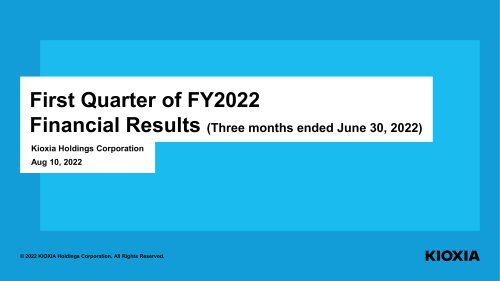
Catalog excerpts

Why KIOXIA’s TLC 3D BiCS FLASH™ outperforms 2D MLC flash technology One of the most critical elements of any embedded application is its memory. After all, it’s where the program and the stored data all go. No wonder that engineers spend so much time during product development in the selection of this core component. In order to pack more data into each device, flash memory manufacturers have turned to storing more than one bit of data in each cell of memory. In 2D planar memory designs this provided the industry with a way of expanding memory capacity without increasing the die size. It was, however, not without some incurred cost. As design engineers are well-aware, flash memory wears out as its cells are erased and written. This means that the lifetime of flash memory is limited. Storing several bits of data per cell, using Multi-Level Cell (MLC) techniques, causes the memory cell to wear out faster than when using a Single-Level Cell (SLC) technique that stores one bit per cell. As a result, application areas with lifetime expectations of more than a decade, and those in the areas of high reliability and robustness, became reluctant to use anything other than SLC flash technolo
Open the catalog to page 1
KIOXIA e-MMC Storage for Data-Intensive Driving To overcome the need to simply make larger die using 2D planar approaches, KIOXIA, the inventor of flash memory, launched 3D flash technology. Instead of relying on ever finer fabrication processes to deliver more memory cells per die, this new technique went into the third dimension. Starting with a 48-layer demonstration device, it became clear that this was a significant step in improving capacity limitations. In addition, these first devices also stored several bits per cell using a Triple-Level Cell (TLC) approach. This was made possible...
Open the catalog to page 2
recognized as offering the world’s largest flash memory production capacity. The use of techniques that store multiple bits per cell, such as TLC, to provide design engineers and consumers with the enormous memory capacities they are demanding will continue. Thanks to all the advancements in flash memory technology that KIOXIA is developing, you can be sure that your application’s memory will stand the test of time. Find out more about KIOXIA’s BiCS FLASH™ 3D flash memory technology here KIOXIA Europe GmbH Hansaallee 181, 40549 Düsseldorf, Germany Tel +49-211-36877-0 www.kioxia.com
Open the catalog to page 3All KIOXIA catalogs and technical brochures
-
EXCERIA PLUS Portable SSD
3 Pages
-
EXCERIA SATA SSD
3 Pages
-
EXCERIA NVMe ™ SSD
3 Pages
-
EXCERIA G2 NVMe™ SSD
3 Pages
-
EXCERIA PLUS G2 NVMe ™ SSD
3 Pages
-
EXCERIA PRO NVMe™ SSD
3 Pages
-
Enterprise SSDs
2 Pages











